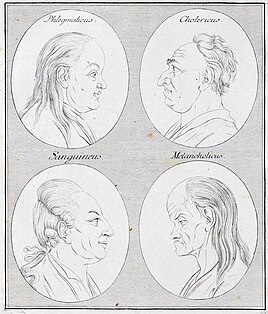
An intelligence quotient (IQ) is a total score derived from several standardized tests designed to assess human intelligence. The abbreviation "IQ" was coined by the psychologist William Stern for the German term Intelligenzquotient, his term for a scoring method for intelligence tests at University of Breslau he advocated in a 1912 book. Historically, IQ is a score obtained by dividing a person's mental age score, obtained by administering an intelligence test, by the person's chronological age, both expressed in terms of years and months. The resulting fraction is multiplied by 100 to obtain the IQ score.
Psychometrics is a field of study concerned with the theory and technique of psychological measurement. As defined by the US National Council on Measurement in Education (NCME), psychometrics refers to psychological measurement. Generally, it refers to the field in psychology and education that is devoted to testing, measurement, assessment, and related activities.
Psychological testing is the administration of psychological tests, which are designed to be "an objective and standardized measure of a sample of behavior". The term sample of behavior refers to an individual's performance on tasks that have usually been prescribed beforehand. The samples of behavior that make up a paper-and-pencil test, the most common type of test, are a series of items. Performance on these items produce a test score. A score on a well-constructed test is believed to reflect a psychological construct such as achievement in a school subject, cognitive ability, aptitude, emotional functioning, personality, etc. Differences in test scores are thought to reflect individual differences in the construct the test is supposed to measure. The science behind psychological testing is psychometrics.

The Rorschach test is a psychological test in which subjects' perceptions of inkblots are recorded and then analyzed using psychological interpretation, complex algorithms, or both. Some psychologists use this test to examine a person's personality characteristics and emotional functioning. It has been employed to detect underlying thought disorder, especially in cases where patients are reluctant to describe their thinking processes openly. The test is named after its creator, Swiss psychologist Hermann Rorschach. In the 1960s, the Rorschach was the most widely used projective test.
Neuropsychological tests are specifically designed tasks used to measure a psychological function known to be linked to a particular brain structure or pathway. Tests are used for research into brain function and in a clinical setting for the diagnosis of deficits. They usually involve the systematic administration of clearly defined procedures in a formal environment. Neuropsychological tests are typically administered to a single person working with an examiner in a quiet office environment, free from distractions. As such, it can be argued that neuropsychological tests at times offer an estimate of a person's peak level of cognitive performance. Neuropsychological tests are a core component of the process of conducting neuropsychological assessment, along with personal, interpersonal and contextual factors.
Educational assessment or educational evaluation is the systematic process of documenting and using empirical data on the knowledge, skill, attitudes, and beliefs to refine programs and improve student learning. Assessment data can be obtained from directly examining student work to assess the achievement of learning outcomes or can be based on data from which one can make inferences about learning. Assessment is often used interchangeably with test, but not limited to tests. Assessment can focus on the individual learner, the learning community, a course, an academic program, the institution, or the educational system as a whole. The word 'assessment' came into use in an educational context after the Second World War.

A personality test is a method of assessing human personality constructs. Most personality assessment instruments are in fact introspective self-report questionnaire measures or reports from life records (L-data) such as rating scales. Attempts to construct actual performance tests of personality have been very limited even though Raymond Cattell with his colleague Frank Warburton compiled a list of over 2000 separate objective tests that could be used in constructing objective personality tests. One exception however, was the Objective-Analytic Test Battery, a performance test designed to quantitatively measure 10 factor-analytically discerned personality trait dimensions. A major problem with both L-data and Q-data methods is that because of item transparency, rating scales and self-report questionnaires are highly susceptible to motivational and response distortion ranging all the way from lack of adequate self-insight to downright dissimulation depending on the reason/motivation for the assessment being undertaken.
Electronic assessment, also known as digital assessment, e-assessment, online assessment or computer-based assessment, is the use of information technology in assessment such as educational assessment, health assessment, psychiatric assessment, and psychological assessment. This covers a wide range of activity ranging from the use of a word processor for assignments to on-screen testing. Specific types of e-assessment include multiple choice, online/electronic submission, computerized adaptive testing and computerized classification testing.

The National Blue Ribbon Schools Program is a U.S. Department of Education award program created in 1982 that recognizes exemplary public and non-public schools on a yearly basis. Using standards of excellence evidenced by student achievement measures, the Department honors high-performing schools and schools that are making great strides in closing any achievement gaps between students.
The Common European Framework of Reference for Languages: Learning, Teaching, Assessment, abbreviated in English as CEFR or CEF or CEFRL, is a guideline used to describe achievements of learners of foreign languages across Europe and, increasingly, in other countries. It was put together by the Council of Europe as the main part of the project "Language Learning for European Citizenship" between 1989 and 1996. Its main aim is to provide a method of learning, teaching and assessing which applies to all languages in Europe. In November 2001, a European Union Council Resolution recommended using the CEFR to set up systems of validation of language ability. The six reference levels are becoming widely accepted as the European standard for grading an individual's language proficiency.

The Texas Assessment of Knowledge and Skills (TAKS) was the fourth Texas state standardized test previously used in grade 3-8 and grade 9-11 to assess students' attainment of reading, writing, math, science, and social studies skills required under Texas education standards. It is developed and scored by Pearson Educational Measurement with close supervision by the Texas Education Agency. Though created before the No Child Left Behind Act was passed, it complied with the law. It replaced the previous test, called the Texas Assessment of Academic Skills (TAAS), in 2002.
Educational evaluation is the evaluation process of characterizing and appraising some aspect/s of an educational process.
ISO/IEC 17025General requirements for the competence of testing and calibration laboratories is the main ISO standard used by testing and calibration laboratories. In most countries, ISO/IEC 17025 is the standard for which most labs must hold accreditation in order to be deemed technically competent. In many cases, suppliers and regulatory authorities will not accept test or calibration results from a lab that is not accredited. Originally known as ISO/IEC Guide 25, ISO/IEC 17025 was initially issued by the International Organization for Standardization in 1999. There are many commonalities with the ISO 9000 standard, but ISO/IEC 17025 is more specific in requirements for competence and applies directly to those organizations that produce testing and calibration results and is based on somewhat more technical principles.. Laboratories use ISO/IEC 17025 to implement a quality system aimed at improving their ability to consistently produce valid results. It is also the basis for accreditation from an accreditation body.
Career assessments are tools that are designed to help individuals understand how a variety of personal attributes, impact their potential success and satisfaction with different career options and work environments. Career assessments have played a critical role in career development and the economy in the last century. Assessments of some or all of these attributes are often used by individuals or organizations, such as university career service centers, career counselors, outplacement companies, corporate human resources staff, executive coaches, vocational rehabilitation counselors, and guidance counselors to help individuals make more informed career decisions.
The Australasian New Car Assessment Program (ANCAP) is a car safety performance assessment programme based in Australia and founded in 1993. ANCAP specialises in the crash testing of automobiles sold in Australia and the publishing of these results for the benefit of consumers. ANCAP provides consumers with transparent advice and information on the level of occupant and pedestrian protection provided by different vehicle models in the most common types of crashes, as well as their ability—through technology—to avoid a crash.
Language assessment or language testing is a field of study under the umbrella of applied linguistics. Its main focus is the assessment of first, second or other language in the school, college, or university context; assessment of language use in the workplace; and assessment of language in the immigration, citizenship, and asylum contexts. The assessment may include listening, speaking, reading, writing, an integration of two or more of these skills, or other constructs of language ability. Equal weight may be placed on knowledge and proficiency, or greater weight may be given to one aspect or the other.
Psychological assessment is defined as a way of assessing an individual's cognitive, academic, behavioral, social-emotional, and adaptive functioning. It is broader than psychoeducational assessment which generally focuses on an individual's functioning in the aforementioned domains within the educational setting and whether the invididual may receive interventions and accommodations in an educational setting. Stefan C. Dombrowski has written a text that provides more elaborate details on the many areas of overlap and distinction between psychoeducational and psychological assessment. Generally, psychological assessment focuses not only on children and adolescents but also adults addressing such issues as child custody, termination of parental rights, malingering and fitness for a particular vocation among others. Regardless of whether one talks about a psychoeducational or psychological assessment, the purpose is to better understand an individual's overall functioning, arrive at a diagnostic conclusion, and offer recommendations to guide treatment or that serve to improve the individual's overall well-being.
Controlled Oral Word Association Test, abbreviated COWA or COWAT, is a verbal fluency test that measures spontaneous production of words belonging to the same category or beginning with some designated letter.






